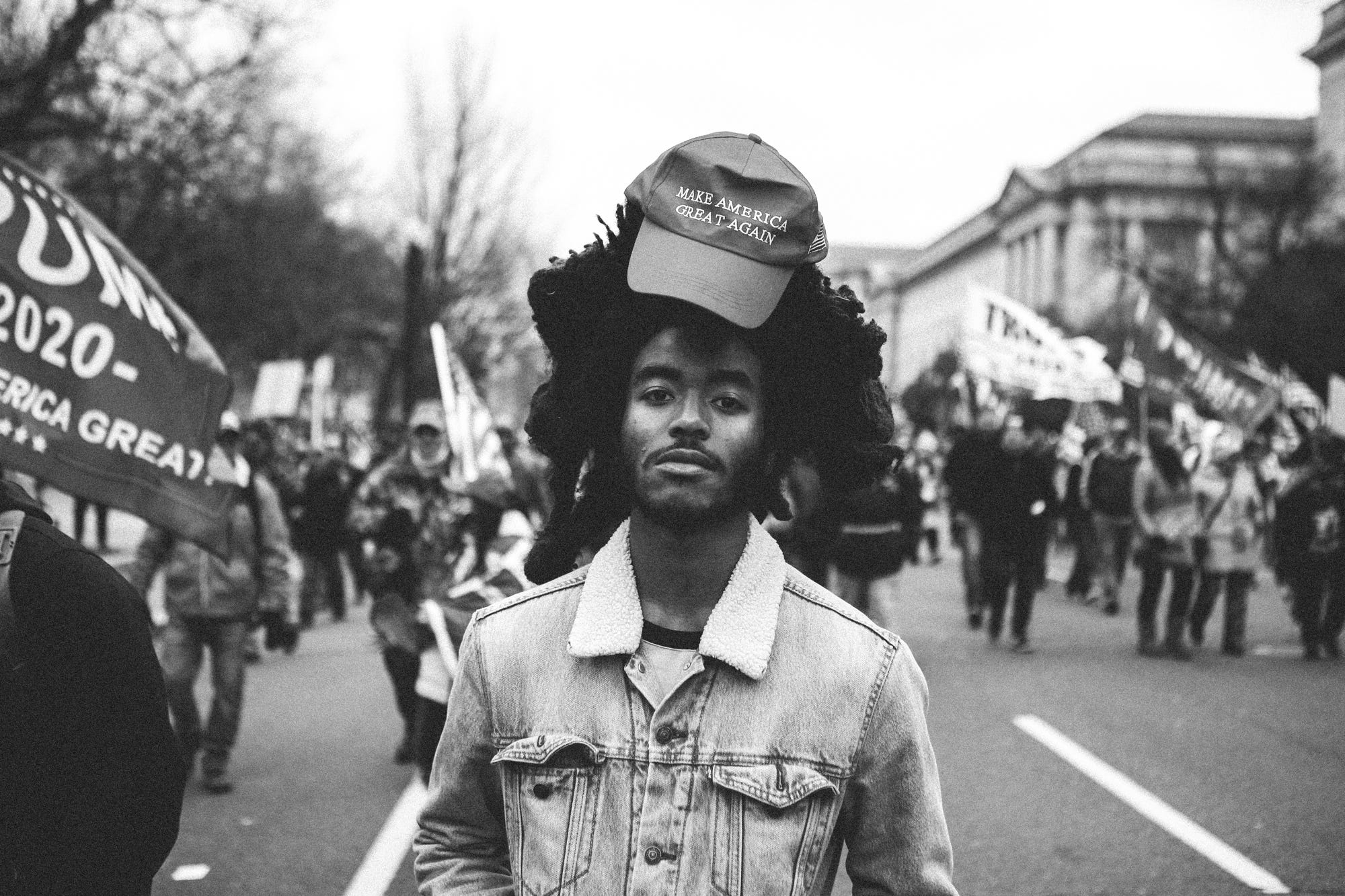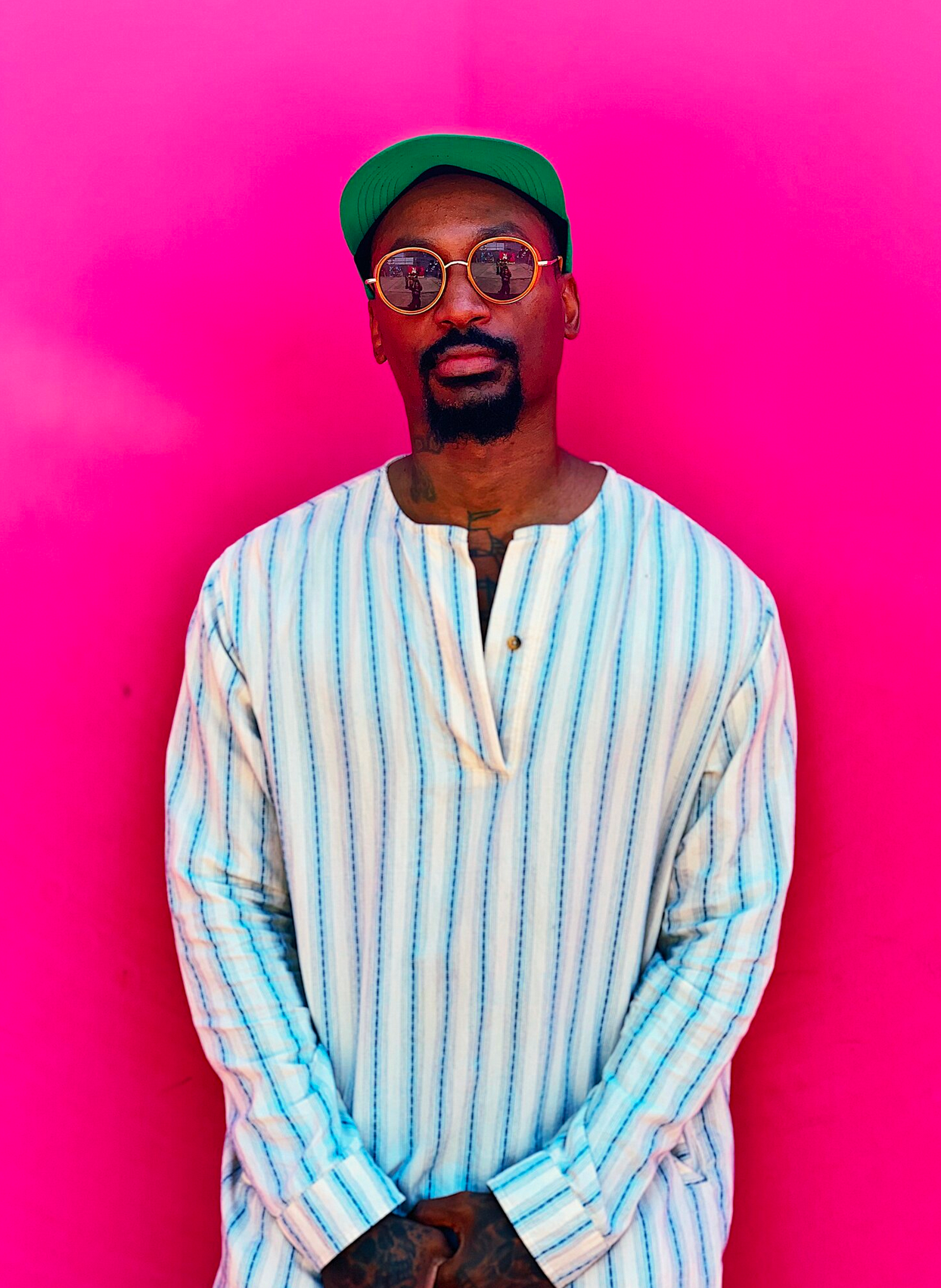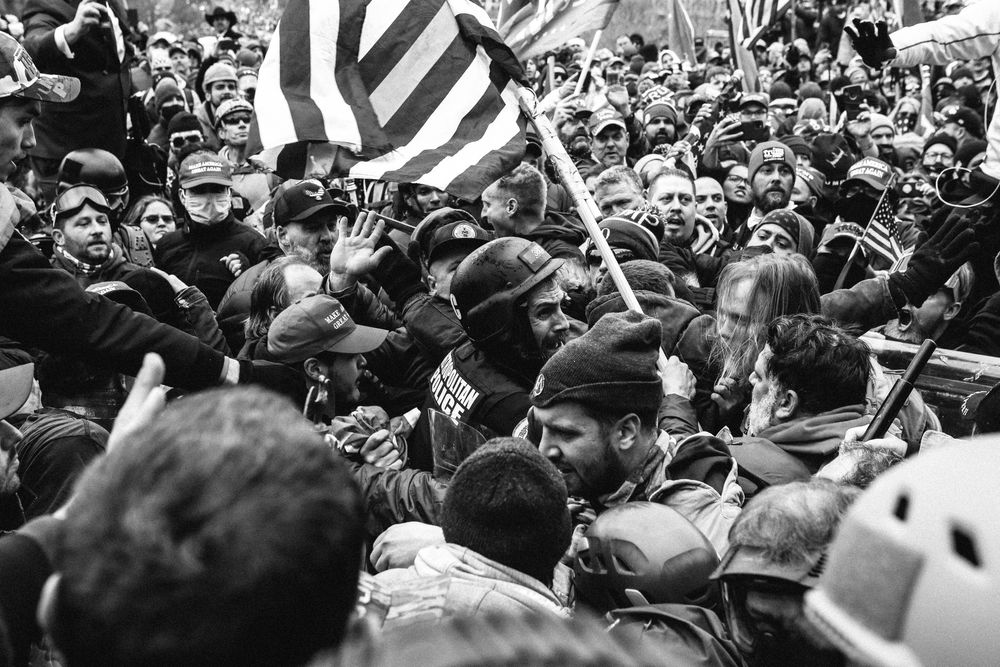“Kill him with his own gun!”
On January 6, photographer Mel D. Cole watched in horror as a police officer attempting to reach the entrance of the Capitol building was dragged down the steps by a mob of rioters. Though he was shocked, Cole didn’t put his camera down; instead, he exhibited the resolve to photograph the cop being beaten, robbed of his badge, and nearly killed with his own weapon.
The result was an image that halts breathing. To witness it is to feel a sense of suffocation.
It was only one of the dozens of pictures and videos Cole captured within the chaos at the Capitol — images that would go viral on his Instagram account the following day. On his feed are stunning shots and short visuals of rioters in various emotional states, from enraged (waving an American flag and yelling to rally rioters) to pained (crying while desperately pouring water or milk into gas-stung eyes). His following spiked from 74,000 to over 124,000; CNN and the New York Times came calling. January 6 stands now as the most disruptive day of the photographer’s life and potentially the most definitive of his career.
Cole didn’t just stumble upon the insanity at the Capitol. The Syracuse-raised 44-year-old drove from his Jersey City apartment, which he shares with his Australian wife and two-year-old son, expressly looking for trouble in D.C. “I thought that some shit would happen, but I didn’t think it would be what it turned out to be,” he says via a phone call. “I thought it’d be some yelling and shoving, maybe some pepper spray, but nothing like what we saw.”
Cole described swirling inside the crux of the insurrection to “being in the middle of a movie that you can’t stop or press fast-forward.” The experience terrified him as much as it educated him about his fellow citizens. “What fucked me up was this older lady literally looked me in the face and said, ‘I’m ready to die for my grandkids and take back this country,’” Cole recalls. “This was after two women already had gotten killed.”
The lensman being in a position to document such history didn’t come without pain, both physical and psychological. He first thought he might die when he couldn’t breathe past the tear gas. Being a Black man surrounded by mobs of angry White people kept a prayer scrolling in his head. Nonetheless, on that day outside the Capitol, it was the police that Cole feared more than any protester. “I’ve been at protests in the city where a Black man will get sprayed right in the face even though there’s a sea of White folks around,” he says.
Last spring, torn between quarantine-induced cabin fever and leeriness of human contact, Cole grabbed his camera and began documenting the new normal of Covid-19 from his car. Then George Floyd was killed, and the people took to the streets. The photographer followed and snapped away. 2020 saw him get harassed by cops, falsely arrested, forced to sleep overnight in jail, and yet never once brought up on charges. “Just guilty of being Black and taking photos,” he says.
While Cole’s vision is his strongest muscle, a commitment to capturing the moment is where his heart beats. The night of the insurrection, he cried on Instagram Live, vulnerably raw while reliving the reality and fear behind his fresh treasure of footage. Yet, less than two weeks later, he was back in a lion’s den. January 18 was Lobby Day in Richmond, Virginia — a gun-rights rally where Proud Boys and Boogaloo Bois alike would be present. So would the Black Lives Matter 757 chapter and the Fred Hampton Gun Club. All in an open-carry state, both sides strapped with semiautomatic firearms.
“I’m fascinated with guns and people who are all about the Second Amendment,” says Cole. “Plus I heard NFA — the Not Fuckin’ Around Coalition — was gonna be there. I hadn’t documented any Black militant groups with guns out, so that was motivation.”
While Cole captured great shots of Black Panthers and right-wing militia members, his catch of the day was an impromptu video interview with one of the Proud Boys’ leaders. “Fuck it,” he thought. “I’m gonna go hard with the question that everyone wants to know.” So he asked the guy straight-up: Are you a white supremacist organization? And what he got back was something he calls “the best sound bite ever.”

“Not at all,” answered the White man while clutching his Proud Boys flag. “I’m a nonracist, in fact. I’m a hip-hop junkie.”
Ironically, Cole credits hip-hop for allowing him to find his purpose in photography. In 2002, Cole headed to legendary New York club S.O.B.’s to watch Common spit his new album Electric Circus. He’d brought a disposable camera simply for personal memories; when he developed the film later, he realized he had a serious eye. So he purchased a digital camera, followed the music, and began shooting concerts and events. Eventually, he landed backstage at a few Roots concerts and befriended the band’s afro-famous percussionist. “If it wasn’t for Questlove,” he says, “my career wouldn’t be where it is today.”
It was 2009, and Cole was shooting at Q-Tip’s birthday party. When he attempted to enter a VIP section to get shots of Jay-Z and Sean Combs, the Bad Boy founder got the photographer kicked out of the section. Cole tweeted about the situation; Questlove swung into action.
https://twitter.com/questlove/status/1144252502
That was a Thursday night. By Monday, Diddy was on Cole’s phone apologizing and ready to change his life. “It was the most Diddy-ass conversation,” says Cole, laughing at the memory. “‘Hey playboy, it’s Diddy.’ I’m like, ‘I know it’s you, nigga. I been waiting on this call all day!’” Cole became Diddy’s personal photographer for his last white party in Beverly Hills. Soon after, he began traveling the world to shoot artists like Kanye West, Trey Songz, The Roots, and many more.
Being an offspring of hip-hop has given Cole a certain gift for capturing the beauty in his people. No matter how far from Cole’s peripheral, Black folks always stand out — especially when they wear MAGA hats. “There’s always at least one Black person at a Trump rally,” he tells. “I’ve seen them at reelection rallies. [At the insurrection], I saw at least 15 or 20. It’s not a lot but they stick out like a sore thumb.”
“I’m like, ‘You wear that [MAGA] hat in the hood? I know a couple motherfuckers that will see you and on sight try to punch a hole through you.’”
What may have been Cole’s most provocative image and interview was with Rodney Mason, a 21-year-old from Maryland’s nearby Prince George’s County who openly supports the former president. Walking down Constitution Avenue, headed toward the Capitol, Mason calmly and clumsily told Cole why he was anti-Biden — and went on to say that people should have the right to wave the Confederate flag and say “nigger” as long as “they’re not harming anyone.” The video is only slightly more jarring than the photo of Mason, a red MAGA cap perched atop his forest of dreadlocks. “I’m like, ‘You wear that hat in the hood?’” remembers Cole. “‘I know a couple motherfuckers that will see you and on sight try to punch a hole through you.’ But he said he had no problems. Crazy.”
Cole’s curiosity and ability to hold tight the truth while allowing others First Amendment space to manipulate or ignore it has raised his stock from silent cameraman to vocal journalist. “I’ve been to many counter-rallies and protests,” he says, “and there’s nothing being solved during those situations. It’s just violence and screaming and anger. Everyone should have the opportunity to express themselves without confrontation.”

The word “journalist,” though, is still an uncomfortable jacket for Cole. Sometimes the work positions you where you never imagined being; often that position is laden with newer and greater responsibility. It becomes about what is best for the message instead of what is comfortable to the messenger. “I’m not a traditional journalist, and I’ve kind of cringed when people have called me a photojournalist,” he says, “but I’ve learned to accept it. With this job that I’ve given myself comes a responsibility to respect the profession.”
Increased visibility does come with perks and purses. Three weeks after his coverage of the insurrection went wide, Cole is on the brink of securing a new book deal with a major publishing house (his first book, Great: Photographs of Hip-Hop, was released independently last February). Right now, though, it’s about the reciprocity between Cole and his people. He nourishes them with the naked truth — whether ugly or beautiful — and they continue to anoint him one of early 2021’s most important storytellers. But they nourish him as well. After Cole broke down with emotion on Instagram Live following the insurrection, one follower requested his Cash App username. Thirty minutes later, he had $3,000; within a couple of days, it reached $8,000.
“I put that money right back into the work,” he says. “I bought a new camera and two new gas masks.”
